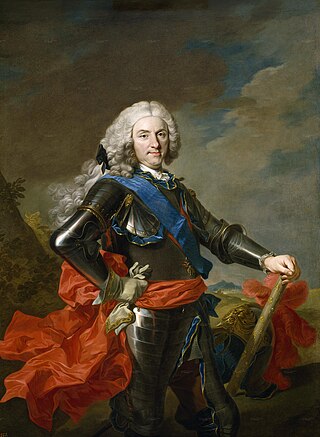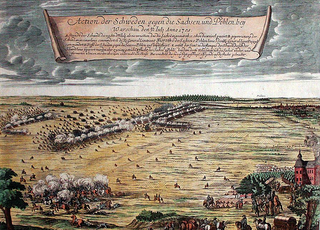Contents
| |||||
| Decades: | |||||
|---|---|---|---|---|---|
| See also: | Other events of 1724 List of years in Spain | ||||
Events in the year 1724 in Spain .
| |||||
| Decades: | |||||
|---|---|---|---|---|---|
| See also: | Other events of 1724 List of years in Spain | ||||
Events in the year 1724 in Spain .
The 1720s decade ran from January 1, 1720, to December 31, 1729. In Europe it was a decade of comparative peace following a lengthy period of near continuous warfare with treaties ending the War of the Quadruple Alliance and the Great Northern War. Both Britain and France saw major financial crashes at the beginning of the decade with the South Sea Bubble and the Mississippi Company respectively. Nonetheless it was a decade of stability in both countries under the leadership of Robert Walpole and Cardinal Fleury and the two nations, recently enemies, formed the Anglo-French Alliance.

1726 (MDCCXXVI) was a common year starting on Tuesday of the Gregorian calendar and a common year starting on Saturday of the Julian calendar, the 1726th year of the Common Era (CE) and Anno Domini (AD) designations, the 726th year of the 2nd millennium, the 26th year of the 18th century, and the 7th year of the 1720s decade. As of the start of 1726, the Gregorian calendar was 11 days ahead of the Julian calendar, which remained in localized use until 1923.

1724 (MDCCXXIV) was a leap year starting on Saturday of the Gregorian calendar and a leap year starting on Wednesday of the Julian calendar, the 1724th year of the Common Era (CE) and Anno Domini (AD) designations, the 724th year of the 2nd millennium, the 24th year of the 18th century, and the 5th year of the 1720s decade. As of the start of 1724, the Gregorian calendar was 11 days ahead of the Julian calendar, which remained in localized use until 1923.

1705 (MDCCV) was a common year starting on Thursday of the Gregorian calendar and a common year starting on Monday of the Julian calendar, the 1705th year of the Common Era (CE) and Anno Domini (AD) designations, the 705th year of the 2nd millennium, the 5th year of the 18th century, and the 6th year of the 1700s decade. As of the start of 1705, the Gregorian calendar was 11 days ahead of the Julian calendar, which remained in localized use until 1923.

The House of Bourbon is a dynasty that originated in the Kingdom of France as a branch of the Capetian dynasty, the royal House of France. Bourbon kings first ruled France and Navarre in the 16th century. A branch descended from the French Bourbons came to rule Spain in the 18th century and is the current Spanish royal family. Further branches, descended from the Spanish Bourbons, held thrones in Naples, Sicily, and Parma. Today, Spain and Luxembourg have monarchs of the House of Bourbon. The royal Bourbons originated in 1272, when Robert, the youngest son of King Louis IX of France, married the heiress of the lordship of Bourbon. The house continued for three centuries as a cadet branch, serving as nobles under the direct Capetian and Valois kings.

Philip V was King of Spain from 1 November 1700 to 14 January 1724 and again from 6 September 1724 to his death in 1746. His total reign is the longest in the history of the Spanish monarchy, surpassing Philip IV. Although his ascent to the throne precipitated the War of the Spanish Succession, Philip V instigated many important reforms in Spain, most especially the centralization of power of the monarchy and the suppression of regional privileges, via the Nueva Planta decrees, and restructuring of the administration of the Spanish Empire on the Iberian Peninsula and its overseas regions.

Charles II was King of Spain from 1665 to 1700. The last monarch from the House of Habsburg, which had ruled Spain since 1516, he died without children, leading to a European conflict over his successor.

Louis I was King of Spain from 15 January 1724 until his death in August the same year. His reign is one of the shortest in history, lasting for just over seven months.

DomJoseph I, known as the Reformer, was King of Portugal from 31 July 1750 until his death in 1777. Among other activities, Joseph was devoted to hunting and the opera. His government was controlled by Sebastião José de Carvalho e Melo, 1st Marquis of Pombal.

The Régence was the period in French history between 1715 and 1723 when King Louis XV was considered a minor and the country was instead governed by Philippe II, Duke of Orléans as prince regent. This was not the only regency in French history but the name is still associated with this period.

Mariana Victoria of Spain was an Infanta of Spain by birth and was later the Queen of Portugal as wife of King Joseph I. She acted as regent of Portugal in 1776–1777, during the last months of her husband's life, and as advisor to her daughter, Maria I of Portugal, during her reign.

Elisabeth of France, also known as Isabel or Elisabeth of Bourbon was Queen of Spain from 1621 to her death and Queen of Portugal from 1621 to 1640, as the first spouse of King Philip IV & III. She served as regent of Spain during the Catalan Revolt in 1640–42 and 1643–44. As the mother of the Queen of France Maria Theresa, wife of Louis XIV, she's the great-grandmother of the Duke of Anjou, who became king of Spain as Philip V. Through her daughter, Elisabeth is the progenitor of the Spanish branch of the House of Bourbon, which still rules over Spain to this day, as all future kings of Spain after the War of Spanish Succession descend from her. She's also the ancestor of the current Grand Duke of Luxembourg, Henri, through both the Bourbon-Parma collateral branch of the Spanish royal family and the main branch of Bourbon dynasty, as he is a descendant of the last Duke of Parma, Robert I, and his mother Louise of Artois, the granddaughter of Charles X of France, through Robert's son Felix.

Maria Luisa Gabriella of Savoy, nicknamed La Savoyana, was Queen of Spain by marriage to King Philip V. She acted as regent during her husband's absence from 1702 until 1703 and had great influence as a political adviser during the War of the Spanish Succession. Because of her effectiveness, she was well-loved in her adoptive country.

Ferdinand II, called Ferdinand the Catholic, was King of Aragon from 1479 until his death in 1516. As the husband and co-ruler of Queen Isabella I of Castile, he was also King of Castile from 1475 to 1504. He reigned jointly with Isabella over a dynastically unified Spain; together they are known as the Catholic Monarchs. Ferdinand is considered the de facto first king of Spain, and was described as such during his reign, even though, legally, Castile and Aragon remained two separate kingdoms until they were formally united by the Nueva Planta decrees issued between 1707 and 1716.

Sebastián de la Cuadra y Llarena, 1st Marquess of Villarías was a Spanish statesman. He served as Chief Minister between 1736 and 1746 during the reign of Philip V of Spain.
The William Ministry was a Spanish government which served between 12 December 1725 and 16 April 1726, headed by John William, Baron Ripperda, born a Dutchman.

Alejandro "Álex" Grimaldo García is a Spanish professional footballer who plays as a left wing-back for Bundesliga club Bayer Leverkusen and the Spain national team. He is known for his crossing, shooting, set-pieces and chance creation.
Events in the year 1910 in Spain.
Juan Bautista de Orendáin y Azpilicueta, 1st Marquess of the Peace, was a Spanish politician who served as prime minister in 1724 and between 1726 and 1734.